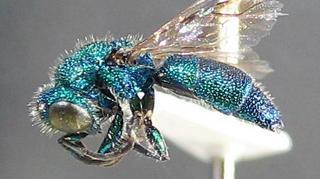
Native Bee Inventory and Monitoring Lab; Photographer: Erika Tucker · 1
Chrysis dorsalis, side |
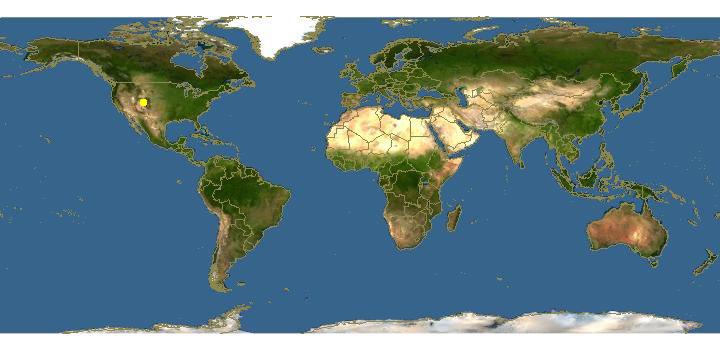
Click on map for details about points.
|
80x5 -
240x3 -
240x4 -
320x1 -
320x2 -
320x3 -
640x1 -
640x2
Set display option above.
Click on
images to enlarge. |
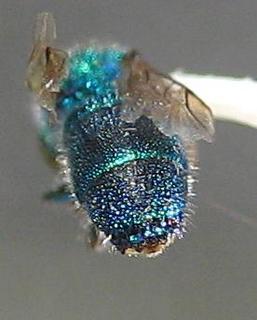
Native Bee Inventory and Monitoring Lab; Photographer: Erika Tucker · 1
Chrysis dorsalis, tail |
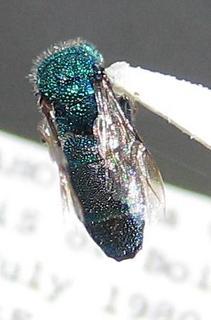
Native Bee Inventory and Monitoring Lab; Photographer: Erika Tucker · 1
Chrysis dorsalis, top |
|
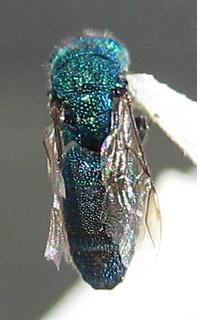
Native Bee Inventory and Monitoring Lab; Photographer: Erika Tucker · 1
Chrysis dorsalis. top |
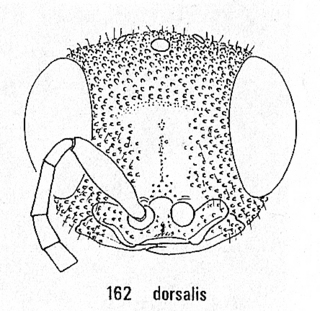
R. M. Bohart and L. S. Kimsey · 1
Chrysis dorsalis, head |
|
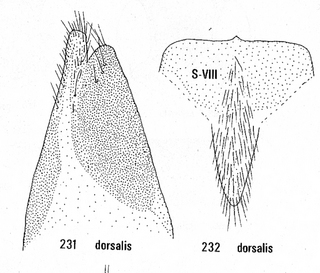
R. M. Bohart and L. S. Kimsey · 1
Chrysis dorsalis, male genitalia |
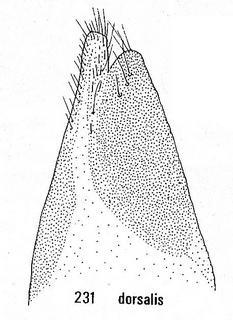
R. M. Bohart and L. S. Kimsey · 1
Chrysis dorsalis, fig. 231 |
|
Overview |
Taken from:
R. M. Bohart and L. S. Kimsey. 1982. A Synopsis of the Chrysididae in America North of Mexico.
Chrysis dorsalis Aaron
(Figs. 162, 231, 232)
Chrysis dorsalis Aaron 1885:234. Lectotype female, Montana (ANSP).
Chrysis alfkenella Buysson 1904:266. Holotype male, Berkeley, California (Paris).
Discussion: Within this rather closely knit species group, dorsalis is the commonest member. For identification of dorsalis attention must be paid to the average size, color, punctation of T-II and shape of T-III as given in the key to species. In doubtful cases it may be necessary to examine the male paramere and S-VIII (figs. 231, 232). The paramere in flattened view, with its strongly cleft apex is distinctive except for meta. Modal body length is 5.0 mm in the male, 6.0 mm in the female, but the range is 4-6 mm in males, and 5-7 mm in females. The male frons is unusually narrow (a little more so than in fig. 160) and the female frons is relatively impunctate medially (fig. 162).
Host: Ferguson (1962) reported a male dorsalis from a cocoon of Photopsis orestes (W. Fox) within a cocoon of Anthidium collectum Huard taken in a ground nest at Antioch, California. Krombein (1979) used this information to record Photopsis sp. as a host of dorsalis. Without denying this possibility, it also seems likely that the usual host is either an Anthidium or some other bee or wasp which may preempt Anthidium cells. Preempting is known to occur frequently in twig nests. Obviously, more observations are needed. In any case the fact that none of the sometimes common species of the dorsalis group have ever been reported from the thousands of harvested twig nests and above ground borings in wooden traps indicates a ground nesting host or hosts.
Material examined: 286 males including type of alfkenella, 222 females including type of dorsalis.
Distribution: Transcontinental in U.S. and southern Canada; also recorded from NORTHWEST TERRITORIES: Fort Smith.
Species group of dorsalis Aaron
Diagnosis: Male F-I longer than F-III and about 1.5-2.0 times as long as broad, female F-I 2.0-2.5 times; subantennal distance a little more or less than 1.0 MOD, shorter than malar space which is 1.5- 2.0 MOD, transverse frontal carina absent or rarely indicated (montana female); in which case eye height equals LID; genal carina separated from eye; midocellus not depressed or lidded; mesopleuron and metanotum rather simple; T-II with a weak and ill-defined median longitudinal ridge; T-III distally with a simple edge and four teeth, laterally a little irregular but essentially straight.
Included species: allectoris Bohart, dorsalis Aaron, equidens Viereck, knowltoni Bohart, Aaron, montana Aaron, paradisica Bohart, pompella Bohart, provancheri Schulz, and scitula Cresson.
Discussion: External characters for species separation are meager in some cases. However, male genitalia, particularly the parameres, are usually definitive (figs. 230-239). Two essential characteristics of these relatively small species are the absence of a definite frontal carina and a moderately long male F-I. The coppery to red coloration in three of the species is unusual among American Chrysis.
Hosts: probably ground nesting bees or wasps (see comments under dorsalis).
Key to the Chrysis dorsalis group
1. Body with extensive coppery to gold or reddish, at least on abdomen ………………..2
Body green to blue to purple, often with some black …………………………………4
2. Color of abdomen not contrasting strongly with that of thorax and head, basic body color green but infused with coppery to golden ……………………………….meta Aaron
Color of abdomen contrasting strongly with that of thorax and head, abdomen usually
extensively coppery red with thorax and head predominantly blue or greenish blue …….3
3. Wings brown stained, scutellum closely and rather coarsely punctate ………………………………………………………………………….provancheri Schulz
Wings nearly clear, scutellum with small polished areas between many small punctures …………………………………………………………………pompella Bohart
4. S-II apically and S-III brown, except usually for a basomedian greenish spot on S-III.. . . …………………………………………………………………………..equidens Viereck
S-II apically or subapically and S-III extensively green to blue ……………………….5
5. T-III with more lateral teeth obtuse and not sharp, all four teeth usually weakly
developed (fig. 182), pit row often shallow, scapal basin extensively polished medially ……………………………………………………………………………scitula Cresson
T-III with more lateral teeth acute (rarely obtuse) and sharp, all four teeth well
developed, pit row deep, scapal basin various ……………………………………………6
6. T-III punctation moderately coarse and rather even, not much finer toward base of colored area; median notch at apex of T-III usually more than a semicircle (fig. 179); frontal brow often with traces of a cross carina …………………………...montana Aaron
T-III punctation coarse toward pit row but becoming much finer on average toward base of colored area, median notch at apex of T-III usually less than a semicircle; frontal brow various ……………………………………………………………………………7
7. T-III with more median pair of teeth almost as sharp as lateral teeth (fig. 180) ……...8
T-III with more median pair of teeth usually considerably more blunt than lateral
teeth (fig. 178) ……………………………………………………………………………9
8. California Sierra along east side from Nevada Co. to Mono Co …………………………………………………………………………...paradisica Bohart
East of 100th meridian ………………………………………………..a1lectoris Bohart
9. T-II with punctures across distal third mostly less than a PD apart, this area not particularly shiny; body length mostly 6-7 mm long ………………………dorsalis Aaron
T-II with punctures across distal third mostly about a PD apart, this area somewhat shiny; body length mostly 7-8 mm long ………………………………...knowltoni Bohart
|
|
| Supported by | |
Updated: 2024-04-28 03:19:30 gmt
|